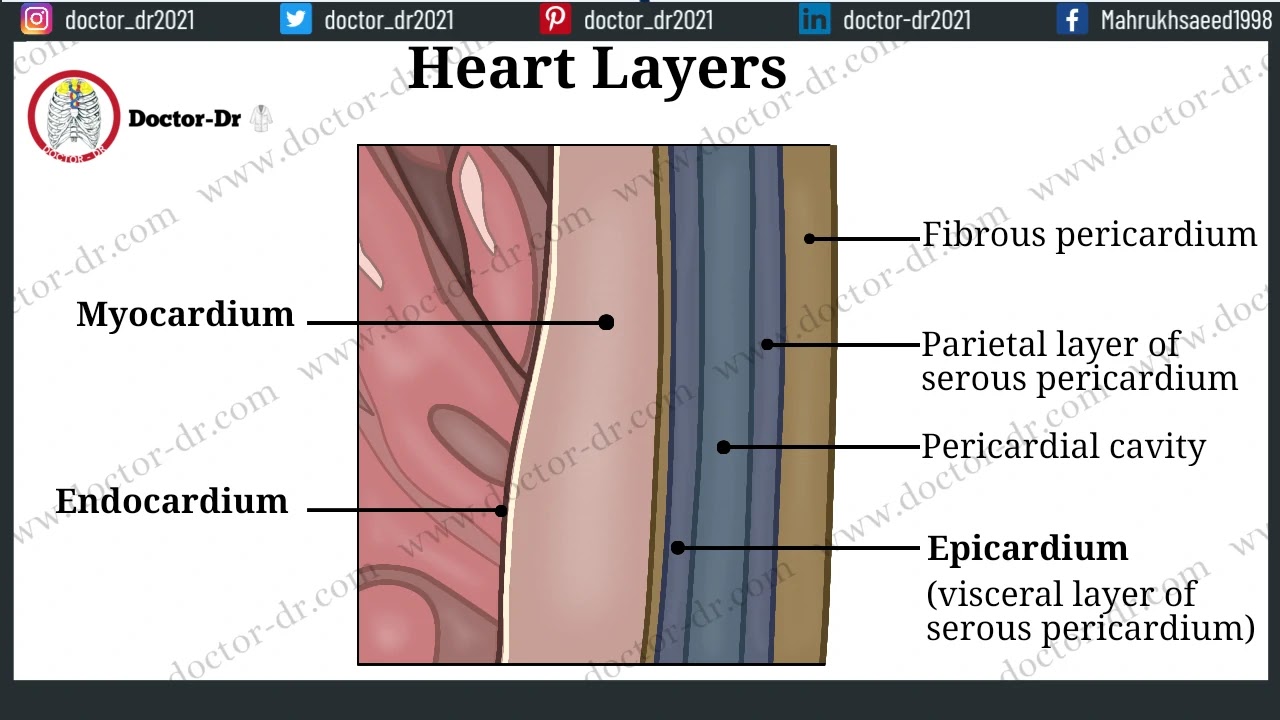The heart comprises three distinct layers:
- Epicardium (the outermost layer)
- Myocardium (situated in the middle)
- Endocardium (the innermost layer)
Table of Contents
1. Epicardium (Outermost Layer of Heart)2. Myocardium (Middle Layer of Heart)
3. Endocardium (Innermost Layer of Heart)
1. Epicardium (Outermost Layer of Heart)
- The epicardium constitutes the heart's outer layer, composed of mesothelium, fat, and connective tissues. It serves as the inner serous layer of the pericardium, often referred to as the visceral serous pericardium.
- This layer envelops both the heart itself and the base of major blood vessels emerging from the heart, such as the aorta and the two vena cava. It is also supplied by numerous coronary blood vessels, nerve fibers, and lymphatic vessels.
- Location-wise, it resides just beneath the parietal serous pericardium layer within the pericardium, establishing direct contact with the myocardium.
Epicardium Structure
- From a histological perspective, the epicardium consists of distinct layers. At its outermost, it comprises a layer of epithelial cells known as the mesothelium. Beneath this layer lies the subserosal layer, composed of connective tissues, as well as a layer of fatty tissues. This can be further subdivided into two layers based on their composition: the serous membrane and the subepicardial layer.
- The serous membrane, the outermost layer, primarily consists of mesothelial tissue. In contrast, the subepicardial layer, situated beneath the serous layer, is composed of loose connective tissues and adipose tissue.
- The subepicardial layer serves as a home to various components such as blood vessels, lymphatic vessels, as well as sympathetic and parasympathetic nerves.
Functions of Epicardium
- Its primary role is to offer mechanical safeguarding for the heart.
- The serous layer produces a delicate fluid known as pericardial fluid, which serves to lubricate the heart and diminish friction while the heart pumps.
- Additionally, being equipped with blood and lymphatic vessels, it aids in the distribution of nutrients and oxygen to the heart wall, as well as the collection and transportation of waste products.
Epicardium-associated Diseases
- Epicardium, on its own, is typically not susceptible to diseases. However, ailments originating in the pericardium or endocardium can sometimes progress to involve the epicardium.
2. Myocardium (Middle Layer of Heart)
- The myocardium, which consists of cardiomyocytes, forms the middle and thickest muscular layer in the heart. Its primary role is to facilitate the heart's contraction and relaxation processes. Notably, the heart's conduction system features a predominant presence of the SA (sinoatrial) and AV (atrioventricular) nodes within this layer.
- Location: It occupies the intermediate position between the epicardium and the endocardium.
Myocardium Structure
- From a histological perspective, the myocardium primarily consists of cardiomyocytes, which are specialized cardiac muscle cells grouped as myofibers, accompanied by a small number of fibroblast cells. These cardiomyocytes are interconnected through structures known as intercalated discs.
- In terms of its anatomical location, the myocardium represents the heart wall's thickest layer. Its thickness varies between the ventricular and auricular walls, with the left ventricle, in particular, being the thickest. Within the left ventricular myocardium, you can further distinguish three sub-layers: the subepicardial, mid-myocardial, and subendocardial layers.
- The myocardium benefits from a rich blood supply, including coronary arteries and coronary veins, as well as a network of cardiac lymphatic vessels. Additionally, it is innervated by a specialized cardiac conduction system composed of unique cardiomyocytes.
Functions of Myocardium
- Its primary role involves contracting and producing the force necessary for the heart wall's rhythmic contractions.
- Within the myocardium, you'll find Pacemaker cells and specialized cardiomyocytes responsible for initiating and transmitting cardiac electrical impulses.
Myocardium-Related Conditions
- The myocardium can be impacted by various illnesses grouped under the term "myocardial diseases." Below are some frequently encountered myocardial diseases.
|
Disease |
Introduction |
|
Myocardial infarction |
Blockage of the blood flow in the
myocardium leads to a heart attack. |
|
Myocarditis |
Inflammation of the
myocardium. |
|
Myocardial fibrosis |
A condition of the formation of excessive
fibrous tissues in the myocardium. |
|
Myocardial
ischemia |
Reduction in the oxygen supply
to the myocardium due to restriction in blood flow. |
Endocardium (Innermost Layer of Heart)
- The endocardium comprises the innermost layer of the heart wall, lining both the heart's internal chambers and its valves. Its purpose is to ensure a smooth surface for optimal blood flow within the heart's chambers. Additionally, it contains capillaries that nourish the cardiac muscles, nerve fibers, and cells involved in heart conduction.
- Location: the endocardium is present on the walls of both the atria and ventricles, and it serves as the outer covering for all four heart valves.
Endocardium Structure
1. Endothelial Layer
2. Sub-endothelial Layer (fibro-elastic tissue layer)
3. Sub-endocardial Layer
Functions of Endocardium
- It forms the lining of the heart chambers and valves, ensuring a non-adhesive surface that promotes efficient blood flow without platelet adhesion or clot formation.
- Additionally, it acts as a barrier between blood and heart tissues.
- This layer facilitates the smooth operation of heart valve opening and closing while accommodating the Purkinje fibers, thus aiding the heart's conduction system.
Endocardium associated medical conditions
|
Disease |
Introduction |
|
Myocardial
infarction |
Blockage of the
blood flow in the myocardium leads to a heart attack. |
|
Myocarditis |
Inflammation of the myocardium. |
|
Myocardial
fibrosis |
A condition of
the formation of excessive fibrous tissues in the myocardium. |
|
Myocardial
ischemia |
Reduction in the oxygen supply to the myocardium due
to restriction in blood flow. |


.webp)
%20Technique%20A%20Comprehensive%20Guide%20to%20Water%20Quality%20Testing%20and%20Microbiological%20Analysis.webp)

.webp)
~1.webp)

.webp)
